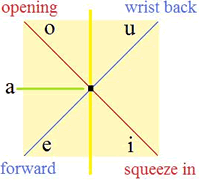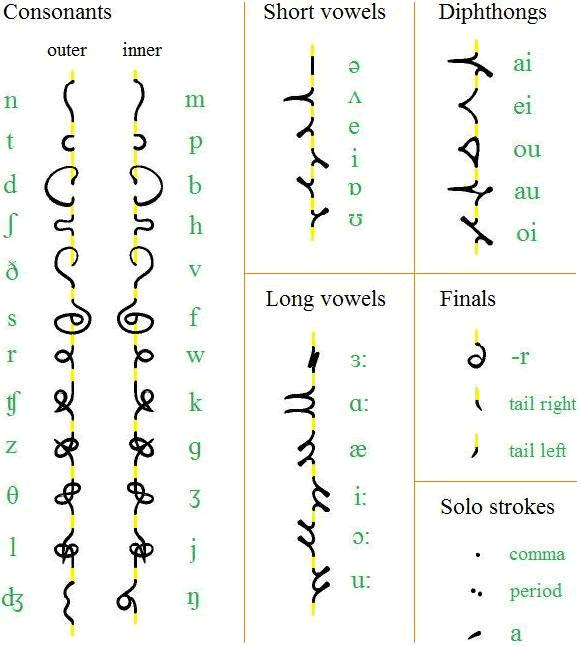Fontok

Fontok is a kind of shorthand invented by Ian James and inspired by the
calligraphic style of China and Japan called wild cursive (k’uang tsao).
Mongolian was also an influence. It is in essence a structured scribbling,
with phonemes assigned to particular movements of the pen. The name comes
from the Thai word for “falling rain”, and also has connotations with
“font” and “phonetics”.
Notable features
- Type of writing system: a cursive phonemic alphabet.
- Direction of writing: vertical columns running from top to bottom – this allows a very comfortable flow of the pen.
- The columns flow left to right – this avoids smudging, and allows us to see what has gone before.
- It is written without diacritics, so each word is formed with a single continuous stroke.
- It was modeled on random word-like scribblings (automatic writing).
- Used to write: English.
Consonants
The consonantal phonemes of English were ranked by frequency, and the
most common were assigned to the easiest, most natural shapes. Rarer phonemes
like /th/ of thing and the /zh/ in measure were assigned to more complicated,
less naturally-flowing shapes.
A relatively small set of curves and knots was chosen, and then mirrored to
bring the total number up to match the number of consonantal phonemes in English.
It turns out that for English, the dental phonemes are generally more common than
the bilabials and velars. For this reason, the more natural side of the central axis
for forming curves (left side for right-handed writers, right side for left-handed writers)
has mainly those phonemes. The mirrored shapes were then given roughly equivalent
articulations to those of the main (outer) side.
Vowels

The vowels of English can be grouped roughly into 6 pairs of short and long, where
each pair is seen to share similar articulation. A long vowel is simply represented
as duplication of a short vowel.
Short vowels are regarded as simple, short lines going out from, and then returning
to, a point. A six-way radial system is the basis of assignment. Since there are two
main axes of movement at the physical level – wrist rotation (blue) and finger squeezing
(red) – the most clearly distinguished vowels are assigned to these. A midway movement
is given to the medium frequency vowel /a/, and the most common vowel schwa is a simple
line following the vertical axis of the word.
Chart
In the following chart of Fontok shapes, the yellow line simply shows the central
axis of the writing. For shapes like /s/ and /d/, a slight extension from the end-point,
or to the start-point, may be drawn.
When the end of a word is reached, a slight tail may be added for aesthetics; the
direction – left or right – is chosen to balance the overall lateral weight of the written
word. This is especially useful in the strictly vertical printed font.
The diphthongs are given with simplified phonetics, to show clearly how the shapes are
derived from two single vowel marks. The solo mark labeled /a/ is an abbreviated form used
for the indefinite article of English

NB. This chart and the vowel diagram were designed for right-handed writers;
left-handers can simply use a mirror image of the system.
Sample text

Transliteration
All human beings are born free and equal in dignity and rights. They are endowed with
reason and conscience and should act towards one another in a spirit of brotherhood.
(Article 1 of the Universal Declaration of Human Rights)
